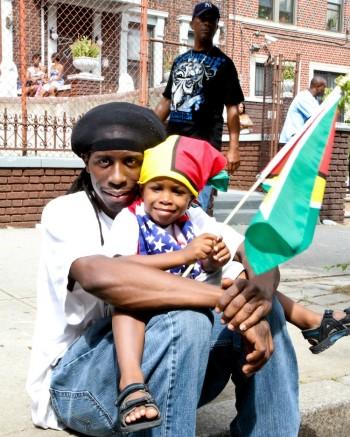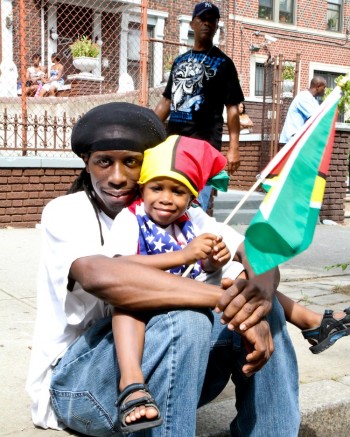NEW YORK—Still early in the day, the 44th annual West Indian American Day Carnival and Parade of Bands was just getting started.
Heading down Nostrand Avenue toward the parade route on Eastern Parkway, a lady in red with a sprawl of red feathers erupting from her head drew the gaze of locals lounging outside bodegas and barber shops.
Parade-goers made their way past a West Indian grocery store, a Trinidadian bakery, and “Guyana Gold” jewelry shop—dull signs of an embedded culture when compared to the eruption of noise and color soon to come.
“We’re trying to keep things under control while we still can,” said a police officer.
“Later on, this area will probably be full of people anyway,” he said, indicating a restricted zone on the sidelines.
The parade draws millions and is the largest festival and parade in the United States. It also has a history of violence. This year lived up to the reputation with two people shot and injured.
The smell of kerosene mixed with jerk and curry. Dreadlocks, sequins, plastic shakers, and flags of all sorts were brandished proudly to declare from where in the West Indies the bearers hail.
“I love the food,” said Blake Shepherd, 22, as he gobbled down barbequed fish.
Shepherd was born and raised in America, but his mother is from Belize, and his father is from Guyana. He had the one flag tied around his upper arm, and the other in his hand. He was happy to share what he appreciates about West Indian culture.
“I love the soca music, the energy we have, the ability to be able to party wherever you are. All we need is music and a dance floor,” said Shepherd.
Reynold Peters from Jamaica agreed. “We love our reggae music and we love to party,” declared Peters.
Peters has been in New York City for 22 years and he’s still getting used to the colder climate. He said the parade reminds him of Jamaica—the difference is the cool breeze that breaks up the heat.
Heading down Nostrand Avenue toward the parade route on Eastern Parkway, a lady in red with a sprawl of red feathers erupting from her head drew the gaze of locals lounging outside bodegas and barber shops.
Parade-goers made their way past a West Indian grocery store, a Trinidadian bakery, and “Guyana Gold” jewelry shop—dull signs of an embedded culture when compared to the eruption of noise and color soon to come.
“We’re trying to keep things under control while we still can,” said a police officer.
“Later on, this area will probably be full of people anyway,” he said, indicating a restricted zone on the sidelines.
The parade draws millions and is the largest festival and parade in the United States. It also has a history of violence. This year lived up to the reputation with two people shot and injured.
The smell of kerosene mixed with jerk and curry. Dreadlocks, sequins, plastic shakers, and flags of all sorts were brandished proudly to declare from where in the West Indies the bearers hail.
“I love the food,” said Blake Shepherd, 22, as he gobbled down barbequed fish.
Shepherd was born and raised in America, but his mother is from Belize, and his father is from Guyana. He had the one flag tied around his upper arm, and the other in his hand. He was happy to share what he appreciates about West Indian culture.
“I love the soca music, the energy we have, the ability to be able to party wherever you are. All we need is music and a dance floor,” said Shepherd.
Reynold Peters from Jamaica agreed. “We love our reggae music and we love to party,” declared Peters.
Peters has been in New York City for 22 years and he’s still getting used to the colder climate. He said the parade reminds him of Jamaica—the difference is the cool breeze that breaks up the heat.
“In Jamaica, you buy one suit and you can wear it all year,” reminisced Peters about relatively unchanging climate in the West Indies.
Flecks of rain threatened the merriment of the ever-increasing crowd, but the downpour held off.
Brooklyn Borough President Marty Markowitz was among the forerunners as the parade made its way down Eastern Parkway. He rode a float that proclaimed in large print “Brooklyn: the Caribbean Capital of America.”
More people of West Indian descent live in New York City than in any other city outside of the West Indies, reports the Department of City Planning. The largest concentration is in the central Brooklyn neighborhoods of Flatbush, East Flatbush, and Crown Heights.
The census information provided by the department also says West Indians are doing fairly well for themselves. The census shows non-Hispanic Caribbean groups have less education but household incomes close to, or above, the city median.
A 1979 State University of New York study noted that “In New York, West Indians are known for their accomplishments in business and professions ... writers on West Indians in New York have pointed out that a high percentage of black professionals are West Indian.”
Following Markowitz, the teachers’ union president Michael Mulgrew and Public Advocate Bill De Blasio were riding some labor-oriented floats—fitting for a Labor Day parade. West Indian corrections officers, West Indian domestic workers, and West Indian transit workers shook their hips and bounced to the fast tempo of the soca beats.
The energy mounted until the whole street seemed to move with the music. The elaborate costumes and floats were as vibrant as the sounds they accompanied.
One figure stood out—he didn’t quite belong in spite of his colorful attire: an elderly gentleman who makes an appearance at many New York City parades whatever their theme or flavor, any excuse to dress up and make merry. Keep an eye out for the man with the colorful beard, platform shoes, and poodle in a baby carriage.
Spectators began to break through the barriers here and there by around 2:30 p.m., with police trying to plug the holes and shoo people back over the barrier where they could. Nostrand was no longer empty, but rather filled with a colorful throng on their way to the parade, which would finish up around 6:30 p.m.
The lady with the red feather cap didn’t appear to have made it to the parade. She sat in a lawn chair on the Nostrand sidewalk, blocks from the parade route, chatting with some friends. She no longer stood out as feathered headdresses, flags, and costumed folk strolled by.
Flecks of rain threatened the merriment of the ever-increasing crowd, but the downpour held off.
Brooklyn Borough President Marty Markowitz was among the forerunners as the parade made its way down Eastern Parkway. He rode a float that proclaimed in large print “Brooklyn: the Caribbean Capital of America.”
More people of West Indian descent live in New York City than in any other city outside of the West Indies, reports the Department of City Planning. The largest concentration is in the central Brooklyn neighborhoods of Flatbush, East Flatbush, and Crown Heights.
The census information provided by the department also says West Indians are doing fairly well for themselves. The census shows non-Hispanic Caribbean groups have less education but household incomes close to, or above, the city median.
A 1979 State University of New York study noted that “In New York, West Indians are known for their accomplishments in business and professions ... writers on West Indians in New York have pointed out that a high percentage of black professionals are West Indian.”
Following Markowitz, the teachers’ union president Michael Mulgrew and Public Advocate Bill De Blasio were riding some labor-oriented floats—fitting for a Labor Day parade. West Indian corrections officers, West Indian domestic workers, and West Indian transit workers shook their hips and bounced to the fast tempo of the soca beats.
The energy mounted until the whole street seemed to move with the music. The elaborate costumes and floats were as vibrant as the sounds they accompanied.
One figure stood out—he didn’t quite belong in spite of his colorful attire: an elderly gentleman who makes an appearance at many New York City parades whatever their theme or flavor, any excuse to dress up and make merry. Keep an eye out for the man with the colorful beard, platform shoes, and poodle in a baby carriage.
Spectators began to break through the barriers here and there by around 2:30 p.m., with police trying to plug the holes and shoo people back over the barrier where they could. Nostrand was no longer empty, but rather filled with a colorful throng on their way to the parade, which would finish up around 6:30 p.m.
The lady with the red feather cap didn’t appear to have made it to the parade. She sat in a lawn chair on the Nostrand sidewalk, blocks from the parade route, chatting with some friends. She no longer stood out as feathered headdresses, flags, and costumed folk strolled by.









Friends Read Free